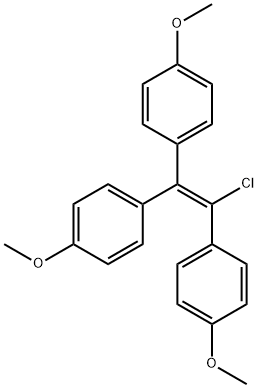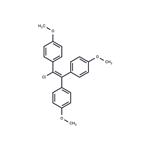Originator
TACE,Merrell ,US ,1952
Uses
Chlorotrianisene USP (TACE) is used to treat Androgen dependent carcinoma of the prostate.
Definition
ChEBI: Chlorotrianisene is a chloroalkene. It has a role as an estrogen receptor modulator, an antineoplastic agent and a xenoestrogen. It derives from a hydride of a stilbene.
Manufacturing Process
The following method is described in US Patent 2,430,891. To a solution of 10
parts of tris-p-methoxyphenyl ethylene in 35 to 40 parts of carbon
tetrachloride is added a solution of 2.0 parts of chlorine in 50 parts of carbon
tetrachloride, with stirring, and over a period of ? hour. The carbon
tetrachloride is then removed by distillation on a steam bath and the residual
oil is recrystallized from 250 to 400 parts of methanol, decolorizing with
charcoal or the like if necessary. Tris-p-methoxyphenyl chloroethylene is
obtained in a yield of 65 to 75%. It melts at 113° to 114°C.
brand name
Tace (Sanofi
Aventis).
Therapeutic Function
Estrogen
General Description
Small white crystals or white powder. Softens at 226°F. Odorless.
Air & Water Reactions
Sensitive to prolonged exposure to air and light. Insoluble in water.
Reactivity Profile
CHLOROTRIANISENE may react vigorously with strong oxidizing agents. Can react exothermically with reducing agents (such as alkali metals and hydrides) to release gaseous hydrogen. May react exothermically with both acids and bases. Various catalysts (such as acids) or initiators can cause very exothermic addition polymerization reactions.
Fire Hazard
Flash point data for CHLOROTRIANISENE are not available. CHLOROTRIANISENE is probably combustible.
Biological Activity
ed50: 2.0 μmglandular kallikrein, a trypsin-like serine protease, has been identified as a major estrogen-induced protein in the rat anterior pituitary. this induction appears to be mediated by increased gene expression since glandular kallikrein mrna is also estrogen-induced. chlorotrianisene is classified as an estrogen agonist.
in vitro
the ed50 of chlorotrianisene were lowered by 3.9-fold. chlorotrianisene inhibited the growth of both p388 and p388/adr cells in a concentration-dependent manner [1].
in vivo
chlorotrianisene markedly varied in its ability to elicit agonist responses on the three measures. on uterine weight and anterior pituitary prolactin, chlorotrianisene behaved as partial agonists. chlorotrianisene also exhibited strikingly less agonist activity on glandular kallikrein than on prl or the uterus. further, the small agonist activity of chlorotrianisene on glandular kallikrein induction differed from that on the uterus or prolactin [2].
References
[1] ramu a, glaubiger d, fuks z. reversal of acquired resistance to doxorubicin in p388 murine leukemia cells by tamoxifen and other triparanol analogues. cancer res. 1984 oct;44(10):4392-5.
[2] powers ca, hatala ma, pagano pj. differential responses of pituitary kallikrein and prolactin to tamoxifen and chlorotrianisene. mol cell endocrinol. 1989 sep;66(1):93-100.
[3] nulsen ro, carmon wb, hendrick ho. tace (chlorotrianisene), a new estrogen for inhibition of lactation. am j obstet gynecol. 1953 may;65(5):1048-51.




